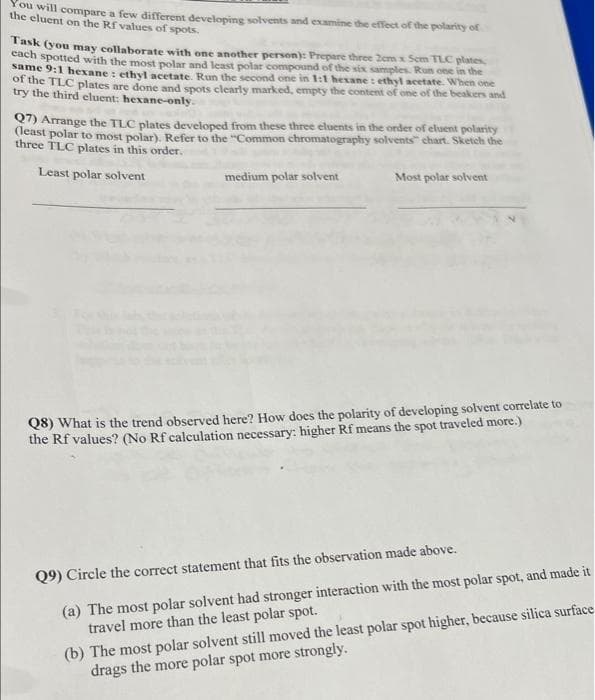Fill compare a few different developing solvents and examine the effect of the polarity of the cluent on the Rf values of spots. Task (you may collaborate with one another person): Prepare three 2cm x Sem TLC plates, each spotted with the most polar and least polar compound of the six samples. Run cone in the same 9:1 hexane: ethyl acetate. Run the second one in 1:1 hexane: ethyl acetate. When one of the TLC plates are done and spots clearly marked, empty the content of one of the beakers and try the third cluent: hexane-only. Q7) Arrange the TLC plates developed from these three eluents in the order of eluent polarity (least polar to most polar). Refer to the "Common chromatography solvents" chart. Sketch the three TLC plates in this order. Least polar solvent medium polar solvent Most polar solvent Q8) What is the trend observed here? How does the polarity of developing solvent correlate to the Rf values? (No Rf calculation necessary: higher Rf means the spot traveled more.) Q9) Circle the correct statement that fits the observation made above. (a) The most polar solvent had stronger interaction with the most polar spot, and made it travel more than the least polar spot. (b) The most polar solvent still moved the least polar spot higher, because silica surface drags the more polar spot more strongly.
Fill compare a few different developing solvents and examine the effect of the polarity of the cluent on the Rf values of spots. Task (you may collaborate with one another person): Prepare three 2cm x Sem TLC plates, each spotted with the most polar and least polar compound of the six samples. Run cone in the same 9:1 hexane: ethyl acetate. Run the second one in 1:1 hexane: ethyl acetate. When one of the TLC plates are done and spots clearly marked, empty the content of one of the beakers and try the third cluent: hexane-only. Q7) Arrange the TLC plates developed from these three eluents in the order of eluent polarity (least polar to most polar). Refer to the "Common chromatography solvents" chart. Sketch the three TLC plates in this order. Least polar solvent medium polar solvent Most polar solvent Q8) What is the trend observed here? How does the polarity of developing solvent correlate to the Rf values? (No Rf calculation necessary: higher Rf means the spot traveled more.) Q9) Circle the correct statement that fits the observation made above. (a) The most polar solvent had stronger interaction with the most polar spot, and made it travel more than the least polar spot. (b) The most polar solvent still moved the least polar spot higher, because silica surface drags the more polar spot more strongly.
Chapter89: Thin-layer Chromatography
Section: Chapter Questions
Problem 5P
Related questions
Question
Chemistry
HELP!!

Transcribed Image Text:ho will compare a few different developing solvents and examine the effect of the polarity of
the cluent on the Rf values of spots.
Task (you may collaborate with one another person): Prepare three 2cm x Sem TLC plates,
each spotted with the most polar and least polar compound of the six samples. Run one in the
same 9:1 hexane: ethyl acetate. Run the second one in 1:1 hexane: ethyl acetate. When one
of the TLC plates are done and spots clearly marked, empty the content of one of the beakers and
try the third cluent: hexane-only.
Q7) Arrange the TLC plates developed from these three eluents in the order of eluent polarity
(least polar to most polar). Refer to the "Common chromatography solvents" chart. Sketch the
three TLC plates in this order.
Least polar solvent
medium polar solvent
Most polar solvent
Q8) What is the trend observed here? How does the polarity of developing solvent correlate to
the Rf values? (No Rf calculation necessary: higher Rf means the spot traveled more.)
Q9) Circle the correct statement that fits the observation made above.
(a) The most polar solvent had stronger interaction with the most polar spot, and made it
travel more than the least polar spot.
(b) The most polar solvent still moved the least polar spot higher, because silica surface
drags the more polar spot more strongly.
Expert Solution
This question has been solved!
Explore an expertly crafted, step-by-step solution for a thorough understanding of key concepts.
Step by step
Solved in 4 steps

Knowledge Booster
Learn more about
Need a deep-dive on the concept behind this application? Look no further. Learn more about this topic, chemistry and related others by exploring similar questions and additional content below.Recommended textbooks for you

EBK A SMALL SCALE APPROACH TO ORGANIC L
Chemistry
ISBN:
9781305446021
Author:
Lampman
Publisher:
CENGAGE LEARNING - CONSIGNMENT

Organic Chemistry: A Guided Inquiry
Chemistry
ISBN:
9780618974122
Author:
Andrei Straumanis
Publisher:
Cengage Learning

EBK A SMALL SCALE APPROACH TO ORGANIC L
Chemistry
ISBN:
9781305446021
Author:
Lampman
Publisher:
CENGAGE LEARNING - CONSIGNMENT

Organic Chemistry: A Guided Inquiry
Chemistry
ISBN:
9780618974122
Author:
Andrei Straumanis
Publisher:
Cengage Learning